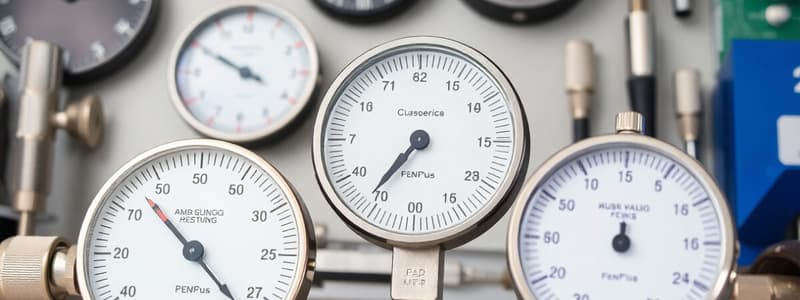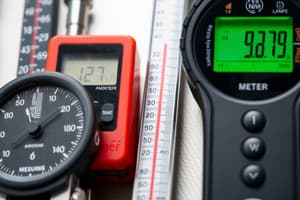Podcast
Questions and Answers
What happens to the pointer in an underdamped instrument?
What happens to the pointer in an underdamped instrument?
- It takes a long time to deflect.
- It immediately remains stationary at zero.
- It oscillates before coming to rest. (correct)
- It reaches the final position without oscillations.
What is a consequence of using double springs in measuring instruments?
What is a consequence of using double springs in measuring instruments?
- They eliminate temperature dependency.
- They increase the friction at the pivot.
- They provide a uniform scale. (correct)
- They simplify the calibration process.
What is a main disadvantage of using springs for control in measuring instruments?
What is a main disadvantage of using springs for control in measuring instruments?
- They require constant adjustment of torque.
- They can develop an inelastic yield. (correct)
- They provide too much damping.
- They cause instability in the reading.
In gravity control instruments, what is the purpose of the adjustable balance weight?
In gravity control instruments, what is the purpose of the adjustable balance weight?
Which factor affects the stiffness of springs used in measuring instruments?
Which factor affects the stiffness of springs used in measuring instruments?
Which classification of instruments does not require calibration with respect to standard instruments?
Which classification of instruments does not require calibration with respect to standard instruments?
What type of instrument is specifically designed to give a continuous record of the variation of the quantity being measured?
What type of instrument is specifically designed to give a continuous record of the variation of the quantity being measured?
Which of the following instruments is considered a secondary instrument?
Which of the following instruments is considered a secondary instrument?
Integrating instruments measure quantities based on what factor?
Integrating instruments measure quantities based on what factor?
Which instrument category includes devices that can measure both A.C. and D.C. quantities?
Which instrument category includes devices that can measure both A.C. and D.C. quantities?
What primary function distinguishes indicating instruments from other types?
What primary function distinguishes indicating instruments from other types?
Which type of instrument typically does not provide relevant data without calibration?
Which type of instrument typically does not provide relevant data without calibration?
What is the primary function of deflecting torque in an indicating instrument?
What is the primary function of deflecting torque in an indicating instrument?
Which type of torque acts in the opposite direction to deflecting torque?
Which type of torque acts in the opposite direction to deflecting torque?
What occurs when damping torque is absent in an indicating instrument?
What occurs when damping torque is absent in an indicating instrument?
Which of the following is NOT a function of controlling torque?
Which of the following is NOT a function of controlling torque?
What happens to the damping torque when the moving system of an indicating instrument is at rest?
What happens to the damping torque when the moving system of an indicating instrument is at rest?
Which effect of electric current would NOT typically be used to produce deflecting torque?
Which effect of electric current would NOT typically be used to produce deflecting torque?
What classification of damping occurs when the system returns to its static position without oscillating?
What classification of damping occurs when the system returns to its static position without oscillating?
How do deflecting and controlling torques behave at steady-state conditions in an indicating instrument?
How do deflecting and controlling torques behave at steady-state conditions in an indicating instrument?
Which torque is responsible for quickly bringing the moving system to rest?
Which torque is responsible for quickly bringing the moving system to rest?
Which statement regarding digital instruments is incorrect?
Which statement regarding digital instruments is incorrect?
Flashcards
Underdamped Instrument
Underdamped Instrument
An instrument where the pointer oscillates but eventually comes to rest.
Overdamped Instrument
Overdamped Instrument
An instrument where the pointer takes a long time to reach its final position without oscillating.
Critical Damping
Critical Damping
The state where the pointer reaches its final position quickly without oscillations.
Spring Control Mechanism
Spring Control Mechanism
Signup and view all the flashcards
Double Springs Advantage
Double Springs Advantage
Signup and view all the flashcards
Measurement
Measurement
Signup and view all the flashcards
Absolute Instruments
Absolute Instruments
Signup and view all the flashcards
Secondary Instruments
Secondary Instruments
Signup and view all the flashcards
Indicating Instruments
Indicating Instruments
Signup and view all the flashcards
Recording Instruments
Recording Instruments
Signup and view all the flashcards
Integrating Instruments
Integrating Instruments
Signup and view all the flashcards
AC and DC Instruments
AC and DC Instruments
Signup and view all the flashcards
Analog Information
Analog Information
Signup and view all the flashcards
Digital Information
Digital Information
Signup and view all the flashcards
Deflecting Torque
Deflecting Torque
Signup and view all the flashcards
Controlling Torque
Controlling Torque
Signup and view all the flashcards
Damping Torque
Damping Torque
Signup and view all the flashcards
Steady State
Steady State
Signup and view all the flashcards
Underdamped
Underdamped
Signup and view all the flashcards
Overdamped
Overdamped
Signup and view all the flashcards
Study Notes
Introduction to Measuring Instruments
- Measurement is comparing an unknown quantity to a predefined standard
- An instrument is a device that determines the value of a quantity
Classification of Instruments
- Absolute Instruments:
- Determine a quantity's magnitude based on instrument constants and deflection
- Do not require comparison with a standard instrument
- Example: tangent galvanometer for measuring electric current
- Secondary Instruments:
- Need calibration against absolute instruments
- Determine quantity value based on instrument deflection
- Calibration is essential; without it, deflection readings are meaningless
- Examples: ammeters, voltmeters, wattmeters
Classification Based on Operation
-
Indicating Instruments:
- Show the instantaneous value of the measured quantity
- Examples: ordinary voltmeters, ammeters, and wattmeters
-
Recording Instruments:
- Provide a continuous record of a quantity's variation over time
- Used in power plants and process industries
- Examples: ECG (Electrocardiogram)
-
Integrating Instruments:
- Measure a quantity over a period of time
- Examples: ampere-hour meter, energy meter
Electrical Instrument Classification
-
A.C. Instruments: measure alternating current quantities
-
D.C. Instruments: measure direct current quantities
-
A.C./D.C. Instruments: measure both alternating and direct current quantities
- Examples include moving iron instruments and dynamometer instruments
-
Analog Instruments:
- Display information continuously
- Easy to understand, calibrate, and maintain
-
Digital Instruments:
- Display information using discrete pulses
- High resolution and readability
Operation of Indicating Instruments
- Deflecting Torque: Causes the moving system to move from rest
- Generated by various effects of electric current (magnetic, electromagnetic induction, heating, chemical, electrostatic)
- Controlling Torque: Limits the movement of the moving system; ensures constant deflection magnitude for a given input
- Acts in the opposite direction to deflecting torque
- Brings the pointer back to zero when the instrument is disconnected
- Damping Torque: Brings the moving system to rest quickly
- Necessary to prevent oscillations
- Active only when the moving system is in motion
Damping Torque
-
Critical Damping:
- Prevents oscillations and the pointer quickly reaches the final position.
-
Under-damped:
- Oscillations occur before settling to the final position.
-
Over-damped:
- Takes a long time to settle to the final position without oscillations.
Spring Control
- Most common control method
- Uses hairsprings (often phosphor bronze)
- Wind in opposite directions to produce a proportional controlling torque
- Balance weight helps center the moving system
Gravity Control
- Uses a small control weight attached to the moving system
- Adjusted to make the zero position vertical
- Control weight exerts a force proportional to sinθ
Studying That Suits You
Use AI to generate personalized quizzes and flashcards to suit your learning preferences.




